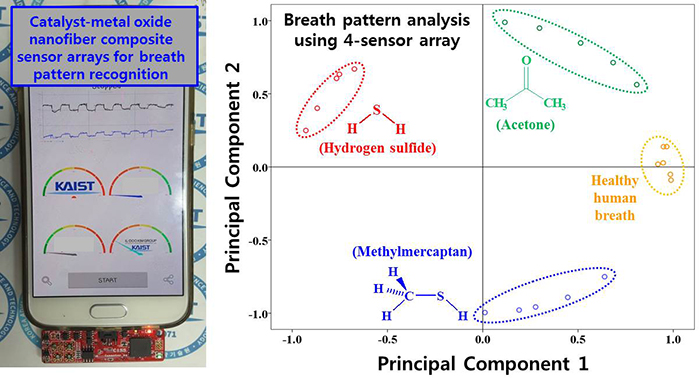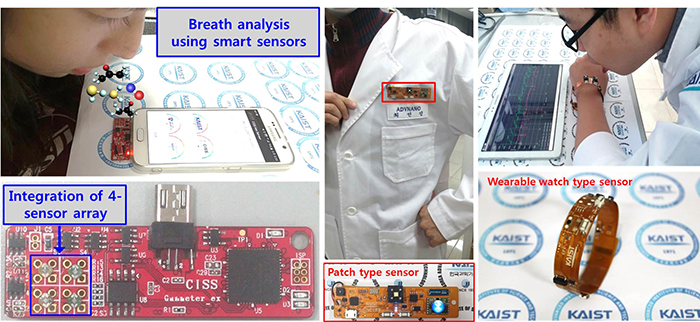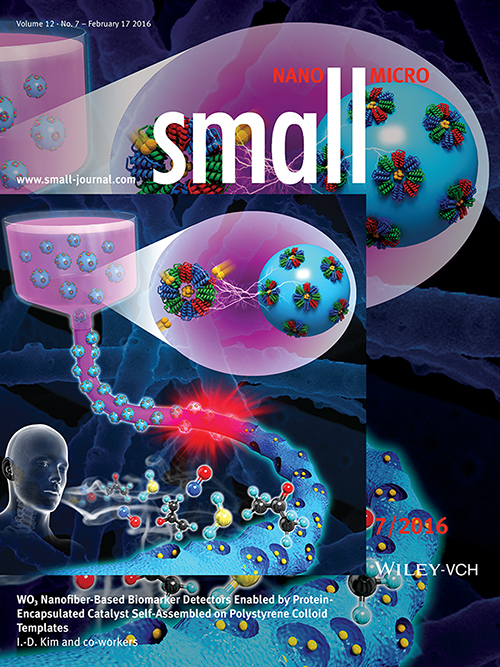A team of researchers has developed a detector that uses exhaled breath to diagnose diseases such as lung cancer and diabetes. Patients can now be diagnosed without the need for any blood tests or MRI scans.
The research team from the Department of Materials Science & Engineering at the Korea Advanced Institute of Science (KAIST) first developed a highly efficient, protein-encapsulated catalyst that can detect gases in exhaled breath that are linked with certain diseases. The team then took this catalyst and applied it to nanofiber-based biomarker detectors to create a hypersensitive, diagnostic sensor that is small enough to connect to a smartphone.

A person's exhaled breath contains traces of volatile organic compound gases. Some of these gases, such as acetone, toluene and hydrogen sulfide, are known to have a strong correlation with diabetes, lung cancer and halitosis. Therefore, if doctors can accurately detect the concentration of these gases in a patient's breath, it will be possible to give early diagnoses of certain illnesses.
Once the team's new sensor is commercialized, patients will no longer need to pay for costly blood tests, biopsies and MRIs to get a diagnosis of diseases such as lung cancer or diabetes, the researchers claim. Instead, patients could be diagnosed around-the-clock using exhalation sensor apps installed on their smartphones or using wearable devices such as watches or patches.

In the following year, the team hopes to apply the new technology to developing a product that analyzes indoor air quality and monitors the level of harmful gases in the environment. Over the next two to five years, the team plans to put the biomarker detector through a stability evaluation process before releasing the finished product: a mobile acetone gas detector that can be used to diagnose diabetes.
By Lee Hana
Korea.net Staff Writer
Photos: KAIST, Department of Materials Science and Engineering
hlee10@korea.kr

The research team from the Department of Materials Science & Engineering at the Korea Advanced Institute of Science (KAIST) first developed a highly efficient, protein-encapsulated catalyst that can detect gases in exhaled breath that are linked with certain diseases. The team then took this catalyst and applied it to nanofiber-based biomarker detectors to create a hypersensitive, diagnostic sensor that is small enough to connect to a smartphone.

The newly developed sensor (left) is connected to a smartphone and can run diagnostics on a patient's exhaled breath. Depending on the patient's health, the diagnosis (right) runs a breath pattern analysis of the levels of different gases present in the person's breath.
A person's exhaled breath contains traces of volatile organic compound gases. Some of these gases, such as acetone, toluene and hydrogen sulfide, are known to have a strong correlation with diabetes, lung cancer and halitosis. Therefore, if doctors can accurately detect the concentration of these gases in a patient's breath, it will be possible to give early diagnoses of certain illnesses.
Once the team's new sensor is commercialized, patients will no longer need to pay for costly blood tests, biopsies and MRIs to get a diagnosis of diseases such as lung cancer or diabetes, the researchers claim. Instead, patients could be diagnosed around-the-clock using exhalation sensor apps installed on their smartphones or using wearable devices such as watches or patches.

A patient's breath gets diagnosed for diseases using a smartphone sensor (left), a patch sensor (center) and a wearable watch sensor.
In the following year, the team hopes to apply the new technology to developing a product that analyzes indoor air quality and monitors the level of harmful gases in the environment. Over the next two to five years, the team plans to put the biomarker detector through a stability evaluation process before releasing the finished product: a mobile acetone gas detector that can be used to diagnose diabetes.
By Lee Hana
Korea.net Staff Writer
Photos: KAIST, Department of Materials Science and Engineering
hlee10@korea.kr

The KAIST research team's paper on nanofiber-based biomarker detectors is the cover story in the Feb. 17 issue of the materials science journal Small.